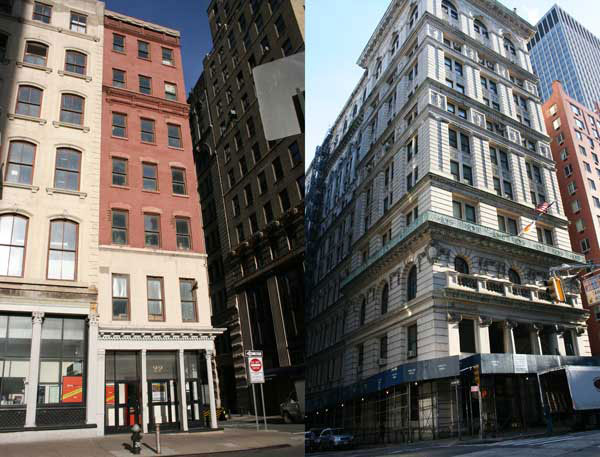
346 Broadway
BY DUSICA SUE MALESEVIC | The city has cut one third of the promised community space at a building that it sold to a developer.
“I feel like I got the rug pulled out [from under] me,” said committee member Tammy Meltzer. “As a community member I feel that already I’m not getting what I was promised. I understood — and I apologize I’m not a real estate maven — I thought we were getting 15,713 square feet of usable space for the community.”
Community Board 1, the new mayor and the building developer are left to handle and haggle over the details of the $160 million sale of 346 Broadway by the Bloomberg administration —with the fallout evident at the Mon., Oct. 6 Planning Committee meeting.
C.B. 1 did not initially support the sale but eventually did with the promise of a 16,000 sq. ft. media center that would serve the community’s youth. But it turns out that 16,000 was really 15,713 sq. ft. of rental space, which actually is 10,000 sq. ft. of space that can be used.
“What the city offered to us, which was something less than we wanted anyway, was 15,700 square feet of a space that would serve youth in some way or another,” said C.B.1 member Tricia Joyce. “Never once in one of these discussions did the idea of gross and net space come up.”
“That is what the community is due, is 16,000 square feet,” said C.B. 1 chairperson Catherine McVay Hughes. “That’s not our problem if someone miscalculated usable, rental or not.”
“It’s not mine, either,” said Don Peebles, chairperson of the Peebles Corp., 346 Broadway’s developer. “We were very transparent, we used the city’s floor plan, the city’s survey, we attached it so there is no ambiguity.”
Peebles is renovating 346 Broadway, also known as 108 Leonard St., with the El Ad Group. He began his presentation by giving an overview of his company and emphasized its many years of renovating landmark buildings and working with communities.
“We were attracted to these buildings because of their landmarked status and the opportunity to restore them,” he said, also referring to 49-51 Chambers St., which his company is not developing. “[We] make sure that our building is an improvement to the community and not a detriment. We are committed to continuing that tradition here.”
Originally, the community space was to go to the east of the lobby. Peebles showed diagrams of the proposed space and then another of the new community space, which will be divided between two floors. The second part of the community space will be in the basement.
“The area that was circled, which is I understand part of the deed was pretty clear, that’s the space,” said Anthony Notaro, committee member. “Yet the changes that have talked about in your slides are very significant. It seems to me that this was made maybe not in good faith.”
Peebles reiterated several times that he was working with the city’s measurements.
“We didn’t create this, this was provided to us based on the city’s survey that D-CAS had done,” he said, referring to the Dept. of Citywide Administrative Services.
There was also a question about the percentage used to calculate the loss of usable space, which was 37 percent.
“I’ve held a commercial lease in Manhattan since 1996, I’ve never heard those kind of percentages,” said Joyce, who’s also chairperson of the board’s Youth Committee.
“Regardless of that, this was not a business lease when D-CAS spoke to the Youth Committee. The community board is not in favor of this sale at all because they forgot to plan infrastructure with the building of 25,000 apartments in Lower Manhattan,” she said.
“From the administration’s perspective, we understand the frustration,” Ashley Thompson, from Mayor Bill de Blasio’s office, said at the meeting. “It should have been very clear from the beginning what the 15,713 square feet actually amounted to.”
“For [the Bloomberg administration] not to be crystal clear with C.B.1 was one failing,” Assemblymember Deborah Glick, who was opposed to the sale of 346 Broadway, told Downtown Express Oct. 1. “I do think the community deserves to get the space it was promised. A deal is a deal is a deal.”
Downtown Community Television Center, at 87 Lafayette St., will be in charge of the new media center.
“None of us asked for a media center,” said committee member Adam Malitz. “Frankly, there are plenty of other needs in the community that outweigh a need for a media center.”
The need for more schools and classroom space has been a continuing issue for Lower Manhattan.
The city contends the new space is less valuable, and Peebles negotiated with the New York City Economic Development Corporation for a compensation price of $2.5 million.
“That two and half million dollar payment really represents about 70 to 75 percent of a recouping of the cost of the space,” said Jeffrey Nelson, executive vice president, real estate transactions, for the E.D.C. “Don’s view is he should pay zero, our view is he should pay some premium. And the number two and a half million is where we landed.”
He said there were many components when determining the value of the space.
The issue of whether that $2.5 million would be committed to C.B. 1’s district was also raised.
“It was determined that we want this money to stay in C.B.1 to the best of our ability,” said Thompson of the mayor’s office. “To the extent that we can work with the board to develop some parameters for the funding.”
“That’s the language that we’ve been hearing, with all due respect,” said Joyce. “It’s a new administration and I know that you mean as well as you can. It’s the same situation where we’ve been hearing that kind of language for a decade. And then what happens is, everything backpedals, ‘oops, someone made a communication mistake and oh we can’t really do it now.’
“This is infrastructure. This isn’t an amenity. We are at a loss for infrastructure. I don’t fault [the Peebles Corp.], the city should have done diligence on this space,” she continued. “Now we have this really complicated problem and we can’t hear from you even that those funds can be committed to for this community.”
The committee passed a resolution asking for the city to get the best deal possible for the adjustment of the community space, and for it to commit to spending the money to benefit the C.B. 1 area.
“This community through the last 13 years, we have major ULURP coming before us, we all know about the South Street Seaport,” said Hughes, referring to the Uniform Land Use Review Procedure. “Depending how this goes will send a clear signal on what’s going to be happening as any other ULURP decision with the city.”































